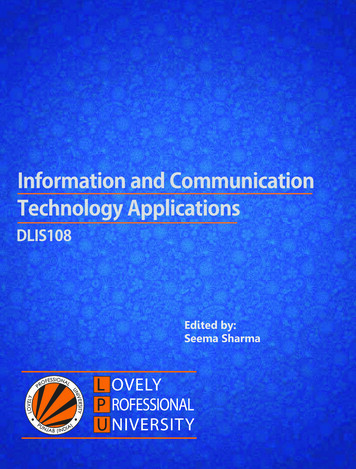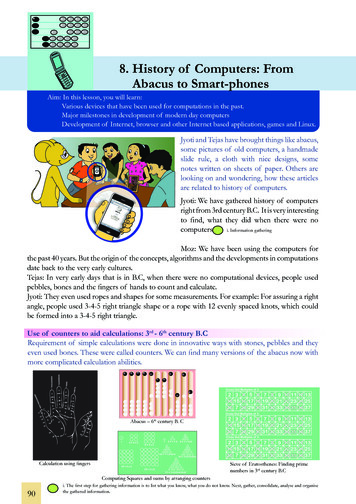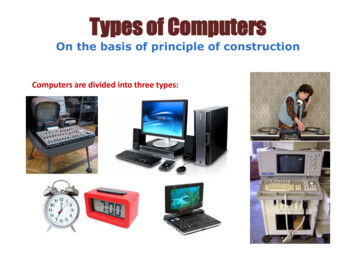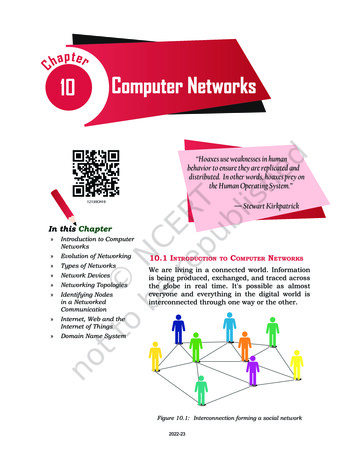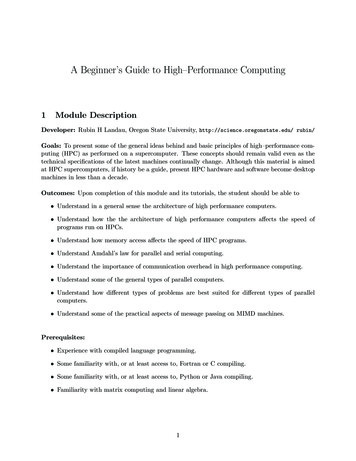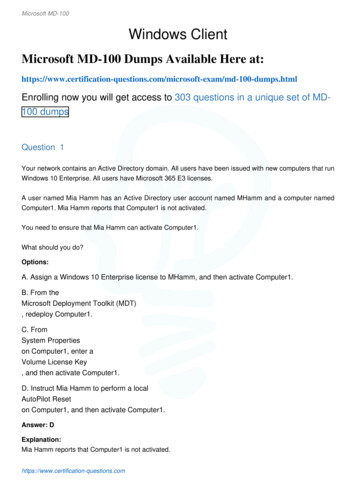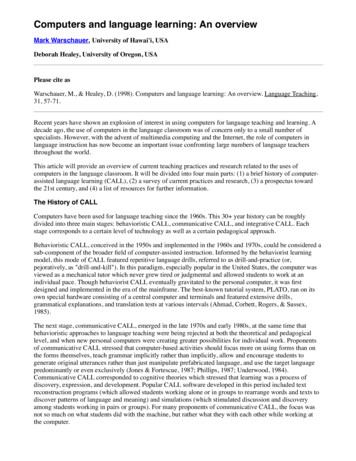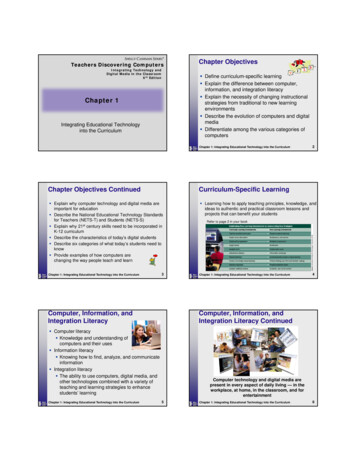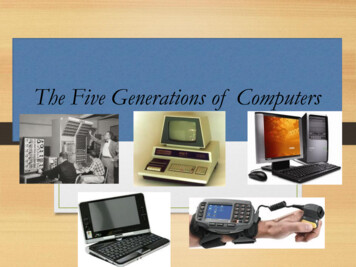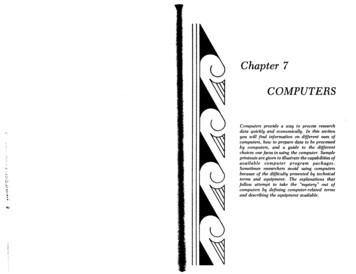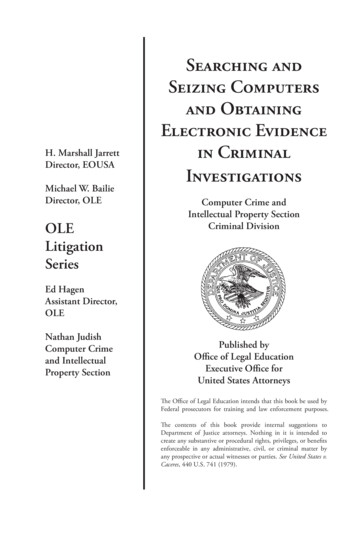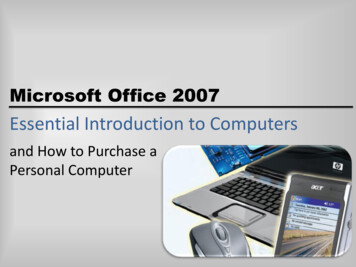
Transcription
Microsoft Office 2007Essential Introduction to Computersand How to Purchase aPersonal Computer
Objectives Define the term computer and discuss the four basiccomputer operations: input, processing, output, andstorage Define data and information Explain the principal components of the computerand their use Describe the use of magnetic disks, USB flash drives,and other storage media Discuss computer software and explain thedifference between system software and applicationsoftwareMicrosoft Office 2007: Introductory Concepts and Techniques - Windows Vista Edition2
Objectives Identify several types of personal computerapplication software Discuss computer communications channels andequipment and the Internet and World WideWeb Define e-commerce Explain how to purchase a personal computerMicrosoft Office 2007: Introductory Concepts and Techniques - Windows Vista Edition3
What is a Computer? An electronic device, operating under the controlof instructions stored in its own memory, thatcan:– Accept data (input)– Process the data according to specified rules(process)– Produce results (output)– Store the results for future use (storage)Microsoft Office 2007: Introductory Concepts and Techniques - Windows Vista Edition4
What is a Computer?Microsoft Office 2007: Introductory Concepts and Techniques - Windows Vista Edition5
What Does a Computer Do? Four basic operations compromise theinformation processing cycleMicrosoft Office 2007: Introductory Concepts and Techniques - Windows Vista Edition6
What are the Components of aComputer? The six primary components of a computer areinput devices, the processor (control unit andarithmetic/logic unit), memory, output devices,storage devices, and communications devices The processor, memory, and storage devices arehoused in a box-like case called the system unitMicrosoft Office 2007: Introductory Concepts and Techniques - Windows Vista Edition7
What are the Components of aComputer?Microsoft Office 2007: Introductory Concepts and Techniques - Windows Vista Edition8
Input Devices An input device is any hardware component thatallows you to enter data, programs, commands,and user responses into a computer– A keyboard is an input device that contains keys youpress to enter data into the computer– A stylus is a small metal or plastic device that lookslike a ballpoint pen, but uses pressure instead of inkto write, draw, or make selections– Smart phones often include a digital camera so userscan send pictures and videos to othersMicrosoft Office 2007: Introductory Concepts and Techniques - Windows Vista Edition9
Input DevicesMicrosoft Office 2007: Introductory Concepts and Techniques - Windows Vista Edition10
Input Devices A mouse is a pointing device that fits comfortablyunder the palm of your hand– Pointer or mouse pointer– Most notebook computers come with a touchpadMicrosoft Office 2007: Introductory Concepts and Techniques - Windows Vista Edition11
System Unit The system unit is a case that contains electroniccomponents of the computer used to processdata– The processor (CPU) interprets and carries out thebasic instructions that operate a computer Arithmetic/logic unit– Memory (RAM) consists of electronic componentsthat temporarily stores instructions waiting to beexecuted by the processor, data needed by thoseinstructions, and the results of processed dataMicrosoft Office 2007: Introductory Concepts and Techniques - Windows Vista Edition12
System UnitMicrosoft Office 2007: Introductory Concepts and Techniques - Windows Vista Edition13
Output Devices Output devices make the information resultingfrom processing available for use– An impact printer prints by striking an inked ribbonagainst the paper– Nonimpact printers form characters by means otherthan striking a ribbon against paper Inkjet– Photo printers LaserMicrosoft Office 2007: Introductory Concepts and Techniques - Windows Vista Edition14
Output DevicesMicrosoft Office 2007: Introductory Concepts and Techniques - Windows Vista Edition15
Display Devices A display device is an output device that visuallyconveys text, graphics, and video information– Monitor Flat panel monitor– LCD CRTMicrosoft Office 2007: Introductory Concepts and Techniques - Windows Vista Edition16
Display DevicesMicrosoft Office 2007: Introductory Concepts and Techniques - Windows Vista Edition17
Storage Devices A storage device is used to store instructions,data, and information when they are not beingused in memory– Magnetic disks use magnetic particles to store itemson a disk’s surface FormattingTrackSectorsPortable storage mediumMicrosoft Office 2007: Introductory Concepts and Techniques - Windows Vista Edition18
Storage Devices A hard disk is a storage device that contains oneor more inflexible, circular platters thatmagnetically store data, instructions, andinformation– Head crash– BackupMicrosoft Office 2007: Introductory Concepts and Techniques - Windows Vista Edition19
Storage Devices A floppy disk is an inexpensive portable storagemediumMicrosoft Office 2007: Introductory Concepts and Techniques - Windows Vista Edition20
Storage Devices An optical disc is aportable storagemedium that consistsof a flat, round,portable disc made ofmetal, plastic, andlacquer that is writtenand read by a laserMicrosoft Office 2007: Introductory Concepts and Techniques - Windows Vista Edition21
Storage Devices Tape is a magnetically coated ribbon of plastichoused in a tape cartridge– Tape driveMicrosoft Office 2007: Introductory Concepts and Techniques - Windows Vista Edition22
Storage Devices Miniature mobile storage media are rewriteablemedia usually in the form of a flash memorycard, USB flash drive, or a smart cardMicrosoft Office 2007: Introductory Concepts and Techniques - Windows Vista Edition23
Storage DevicesMicrosoft Office 2007: Introductory Concepts and Techniques - Windows Vista Edition24
Storage Devices A smart card stores data n a thin microprocessorembedded in the cardMicrosoft Office 2007: Introductory Concepts and Techniques - Windows Vista Edition25
Communications Devices A communications device is a hardwarecomponent that enables a computer to send andreceive data, instructions, and information toand from one or more computers– Transmission mediaMicrosoft Office 2007: Introductory Concepts and Techniques - Windows Vista Edition26
Computer Software System software consists of programs to controlthe operations of computer equipment– Operating system Microsoft Windows VistaMicrosoft Windows XPApple Mac OS XLinux– Booting– Graphical user interface (GUI) IconMicrosoft Office 2007: Introductory Concepts and Techniques - Windows Vista Edition27
Computer Software Application software consists of programsdesigned to make users more productive and/orassist them with personal tasks– Word processing– Spreadsheet– Database– Presentation graphicsMicrosoft Office 2007: Introductory Concepts and Techniques - Windows Vista Edition28
Computer SoftwareMicrosoft Office 2007: Introductory Concepts and Techniques - Windows Vista Edition29
Networks and the Internet A network is a collection of computers anddevices connected together, often wirelessly, viacommunications devices and transmission media– Local area network– Wide area networkMicrosoft Office 2007: Introductory Concepts and Techniques - Windows Vista Edition30
Networks and the Internet The world’s largest network is the Internet, whichis a worldwide collection of networks thatconnects millions of businesses, governmentagencies, educational institutions, andindividuals– Internet service provider (ISP)– Online service provider (OSP)– Wireless Internet service provider (WISP)Microsoft Office 2007: Introductory Concepts and Techniques - Windows Vista Edition31
Networks and the Internet The World Wide Web contains billions ofdocuments called Web pages– Web page– Web site– Web browser– Uniform Resource Locator (URL)– Hypertext transfer protocolMicrosoft Office 2007: Introductory Concepts and Techniques - Windows Vista Edition32
Networks and the Internet When you conduct business activities online, youare participating in electronic commerce, alsoknown as e-commerce– Business to consumer (B2C)– Consumer to consumer (C2C)– Business to business (B2B)Microsoft Office 2007: Introductory Concepts and Techniques - Windows Vista Edition33
How to Purchase a Personal Computer Do you want a desktop computer or mobilecomputer? For what purposes will you use the computer? Should the computer be compatible with thecomputers at school or work?Microsoft Office 2007: Introductory Concepts and Techniques - Windows Vista Edition34
How to Purchase a Desktop Computer Determine the specific software you want to useon your computer Know the System Requirements of the OperatingSystem Look for bundled software Avoid buying the least powerful computeravailable Consider upgrades to the mouse, keyboard,monitor, printer, microphone, and speakersMicrosoft Office 2007: Introductory Concepts and Techniques - Windows Vista Edition35
How to Purchase a Desktop Computer Determine whether you want to use telephone lines orbroadband (cable or DSK) to access the Internet If you are using a dial-up or wireless connection toconnect to the Internet, then select an ISP or OSP Use a worksheet to compare computers, services, andother considerations If you are buying a new computer, you have severalpurchasing options: buying from your school bookstore, alocal computer dealer, a local large retail store, or orderingby mail via telephone or the Web If you are buying a used computer, stay with name brandssuch as Dell, Gateway, Hewlett-Packard, and AppleMicrosoft Office 2007: Introductory Concepts and Techniques - Windows Vista Edition36
How to Purchase a Desktop Computer If you have a computer and are upgrading to anew one, then consider selling or trading in theold one Be aware of hidden costs Consider more than just price Avoid restocking fees Use a credit card to purchase your new computer Consider purchasing an extended warranty orservice planMicrosoft Office 2007: Introductory Concepts and Techniques - Windows Vista Edition37
How to Purchase a Notebook Computer Purchase a notebook computer with asufficiently large active-matrix screen Experiment with different keyboards andpointing devices Make sure the notebook computer you purchasehas a CD and/or DVD drive If necessary, upgrade the processor, memory,and disk storage at the time of purchaseMicrosoft Office 2007: Introductory Concepts and Techniques - Windows Vista Edition38
How to Purchase a Notebook Computer The availability of built-in ports and a port extenderon a notebook computer is important If you plan to use your notebook computer for notetaking at school or in meetings, consider a notebookcomputer that converts to a Tablet PC Purchase a notebook computer with a built-inwireless network connection If you are going to use your notebook computer forlong periods without access to an electrical outlet,purchase a second batteryMicrosoft Office 2007: Introductory Concepts and Techniques - Windows Vista Edition39
How to Purchase a Notebook Computer Purchase a well-padded and well-designedcarrying case If you travel overseas, obtain a set of electricaland telephone adapters If you plan to connect your notebook computerto a video projector, make sure the notebookcomputer is compatible with the video projector For improved security, consider a fingerprintscannerMicrosoft Office 2007: Introductory Concepts and Techniques - Windows Vista Edition40
How to Purchase a Tablet PC Make sure the Tablet PC fits your mobilecomputing needs Decide whether you want a convertible or pureTablet PC Be sure the weight and dimensions areconducive to portability Port availability, battery life, and durability areeven more important with a Tablet PC than theyare with a notebook computerMicrosoft Office 2007: Introductory Concepts and Techniques - Windows Vista Edition41
How to Purchase a Tablet PC Experiment with different models of the TabletPC to find the digital pen that works best for you Check out the comfort level of handwriting indifferent positions Make sure the LCD display device has aresolution high enough to take advantage ofMicrosoft’s ClearType technologies Test the built-in Tablet PC microphone andspeakersMicrosoft Office 2007: Introductory Concepts and Techniques - Windows Vista Edition42
How to Purchase a Tablet PC Consider a Tablet PC with a built-in PC videocamera Review the docking capabilities of the Tablet PC Wireless access to the Internet and your e-mail isessential with a Tablet PC Review available accessories to purchase withyour Tablet PCMicrosoft Office 2007: Introductory Concepts and Techniques - Windows Vista Edition43
How to Purchasea Personal Mobile Device Determine the programs you plan to run on yourdevice Consider how much you want to pay Determine whether you need wireless access tothe Internet and e-mail or mobile telephonecapabilities with your device For wireless devices, determine how and whereyou will use the serviceMicrosoft Office 2007: Introductory Concepts and Techniques - Windows Vista Edition44
How to Purchasea Personal Mobile Device Make sure your device has enough memory andstorage Practice with the touch screen, handwritingrecognition, and built-in keyboard beforedeciding on a model Decide whether you want a color display Compare battery lifeMicrosoft Office 2007: Introductory Concepts and Techniques - Windows Vista Edition45
How to Purchasea Personal Mobile Device Seriously consider the importance of ergonomics Check out the accessories Decide whether you want additionalfunctionality Determine whether synchronization of data withother devices or personal computers is importantMicrosoft Office 2007: Introductory Concepts and Techniques - Windows Vista Edition46
Summary Define the term computer and discuss the four basiccomputer operations: input, processing, output, andstorage Define data and information Explain the principal components of the computerand their use Describe the use of magnetic disks, USB flash drives,and other storage media Discuss computer software and explain thedifference between system software and applicationsoftwareMicrosoft Office 2007: Introductory Concepts and Techniques - Windows Vista Edition47
Summary Identify several types of personal computerapplication software Discuss computer communications channels andequipment and the Internet and World WideWeb Define e-commerce Explain how to purchase a personal computerMicrosoft Office 2007: Introductory Concepts and Techniques - Windows Vista Edition48
Microsoft Office 2007Essential Introduction to ComputersComplete
Use a worksheet to compare computers, services, and other considerations If you are buying a new computer, you have several purchasing options: buying from your school bookstore, a local computer dealer, a local large retail store, or ordering by mail via telephone or the Web If you are buying a used computer, stay with name brands
